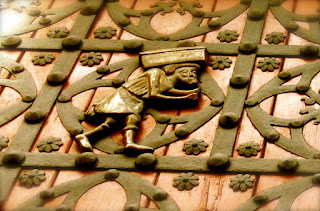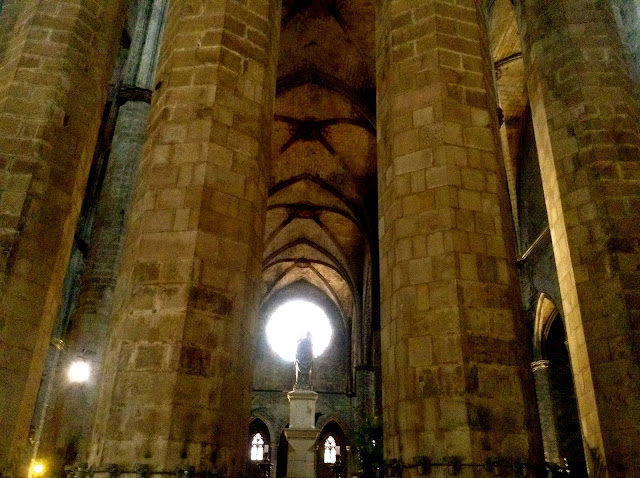This combination of surface plainness and bony structural daring also marks Barcelona's other prime urban church of the fourteenth century, Santa Maria del Mar. The Pi was begun in 1322. Santa Maria del Mar got under way seven years later and took a little more than a half century to build.
It was not far in from the beach, a biblical ark side-on to the harbor, looking as though it had come to rest there after the flood. (One often hears it said that Santa Maria del Mar was actually on the beach and constructed in the sand. This is not true.) The site was in fact very old, and Christian worship had already been conducted there for a thousand years. Santa Maria del Mar is built over a burial site that dates back to the first century A.D., and the original church may have been the first episcopal seat in Barcelona at the time of Constantine, in the fourth century. This little chapel, being close to the beach, was called Santa Maria dels Arenys - Holy Mary of the Sands. Its cult was that of saint Eulalia, patron saint of Barcelona, the virgin martyr who was supposedly buried there in 303. After her remains were moved to the shrine where the Cathedral of Barcelona now stands, the Catalans began a new church on the same site of the old, dedicated to Christ's mother in her role as Patroness of mariners - Mary, Stella Maris, Star of the Sea.
By now the Ribera quarter, where the shrine stood, was exceedingly prosperous. The growth of trade had been good to it. It was surrounded by streets occupied by workers in specific guilds - Carrer del Argenteria (silversmiths) Carrer dels Sombrerers (hatmakers). Being so close to the port, it was associated with haulers and porters. The guild of the bastaixos, or longshoremen, made heavy cash contributions to its building. On the massive oaken portal of the church are two small, easily overlooked fifteenth-century bronze figures of men carrying loads. Inside, at the foot of the main altar, are a pair of stone reliefs. One shows a man shovelling grain from a big pile into a bag, while the other depicts a pair of stevedores carrying a cask slung on a pole between their shoulders. The latter are the macips de Ribera, "freed slaves," whose job it was to load and unload cargo ships. These were the folk whose labor made up for the permenent deficiencies of the harbor. They also brought the stone from the foixada quarry on Montjuic to build the church.
Bernat Llull, the parish priest, laid the foundation stone in 1329, and construction began with the apse, working down toward the front facade - four bays in the nave, flanked by aisles, without a transept, the classic Cistercian plan that descends, without interruption, from the primitive basilicas of the early church. The first architects were Berenguer de Montagut and Ramon Despuig; later they were replaced by Guillem Metge, who died in 1381, three years before the church was consecrated.
For more than fifty years, according to the chronicles, most of the able-bodied population of Barcelona worked on Santa Maris del Mar, which gave it a lasting reputation as a popular church, a building made by workers for workers - though this did not prevent the anarchists from starting a fire in it during the Spanish civil war, destroying most of its accumulated ornaments and fittings, including a huge eighteenth-century organ and an elaborate but incongruous baroque high altar; the fire raged for eleven days, consumed an untold quantity of furniture, sculpture, reliquaries, paintings, and textiles, and somewhat weakened the structure of the church itself. Consequently only the original bones of Santa Maria del Mar are left, but these bones are so beautiful that one finds it hard to regret the loss of the intrusive altar.
By 1379 the apse and three of the four main vaults of the nave were closed, and their circular keystones, each six feet in diameter, were in place. The third vault was finished just before Christmas that year, when the wooden support scaffolding under it caught fire and collapsed. By the time a new scaffolding could be set up, it was clear that the keystone - bearing a colored relief of Saint George, in the Catalan red and yellow stripes, lancing the dragon - had been ruined, but it could not be taken out and replaced without destroying the vault itself. So it was patched up, and the fourth and last vault was at last closed wit due ceremony on November 3, 1383. The first solemn high mass in Santa Maria del Mar was celebrated by Pere de Planella, bishop of Barcelona, nine months later.
Outside, to an eye used to the French or English pointed styles of the fourteenth century, Santa Maria del Mar hardly looks Gothic at all. Where are the sharp ogives, the spires, the filigree, the detached airiness of flying buttresses? Nowhere to be seen: the buttresses that sink the outward thrust of the roof in their mass are solid rectangular blocks, foursquare, and their only ornaments are the rainspout that project like fierce black beaks from the summits. Its bell tower is octagonal, finished with three diminishing octagons, almost as simple as a basalt pipe. the doors are oak, massive and iron studded. Despite the rose window, it looks as opaque as the rock from which it was built, more a fortress than a church: Cistercian in its imagery of plainness and shelter. A sect could make its last stand here.
Inside, the scale is immense. There is no grander or more solemn architectural space in Spain than Santa Maria del Mar. Its plan is Basilican, a central nave with two flanking aisles that swing around to form a semicircular apse; chapels, set between the solid counterpart stub walls that oppose the outward thrust of the roof in lieu of flying buttresses, open from the aisles. The measure of the church is given by its columns, plain octagons in section, which rise to a little more than half the total height of the nave; from their thin capitals, hardly more than rings of gilded holding, spring the ribs of the roof and the Gothic arches of the nave. These ribs are plain stone pipes, and their linear definition against the planes of wall and vault is intensely moving in its abstract purity. The columns of Santa Maria del Mar are very wide apart. In fact their spacing is the widest of any Gothic church in Europe - about forty-three feet apart, center to center. Four of these bays define the nave, and then the rhythm of spacing quickens as eight more columns are planted in a semicircle to define the presbytery, with its altar raised a few feet above the church floor: a grove of stone, whose upper ribs converge in diaphragm arches on the circular keystone. In the morning, the sun strikes in between these diaphragms and dapples them with scribbles and fish scales of color, lifting them in radiance.








































No hay comentarios:
Publicar un comentario